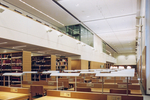As the central academic library of the Republic of Austria, the Austrian National Library (ANL) looks back over a history rich in tradition going as far as the 14th century. It is the living bridge between the rich heritage of the past and the future-oriented demands of a modern information society.
The Austrian National Library regards itself as a centre of information and research oriented toward serving the public, as an outstanding national memory institution and as a many-sided centre of education and culture.
As a service-oriented information centre, the Austrian National Library offers its users access and professional advice on its own holdings (almost eight million objects) and also on international data pools. In addition, it accepts commissions on scientific research, and operates documentation centers and service facilities, for example on literature specifically devoted to women’s studies. Since the beginning of the digital age a steadily increasing part of the services are processed online via the home page of the ANL.
Because of the Austria law on media the Austrian National Library receives- as the only library in the country – copies (Legal deposit) of all publications appearing in Austria, including those from electronic offline media and dissertations approved by Austrian universities. Those obligatory items simultaneously serve as the basis for publication of the Austrian Bibliography. On top of that, the Library systematically selects and collects literature specifically concerning Austria but published in other countries, and literature on the humanities with special attention paid to works that are relevant to its own Departments.
In its eight Departments the Austrian National Library, as the heir to the Habsburg Court Library, conserves a significant part of the world’s documentary heritage, and feels a duty to continue that conservation. Of exceptional international importance are the holdings of antique, medieval, and modern manuscripts from the most varied cultural areas and music autographs, incunabula and old printed works, historic maps, portraits and other pictorial documents, placards, exlibris and broadsheets, and of no less importance the literary estates of Austrian writers. Three museums belonging to the Library present to the public objects from the world’s biggest papyrus collection, from a unique holdings of historic globes, and an impressive collection on the international language Esperanto. The Baroque Hall of State, constructed from 1723 till 1726 according to the plans of Johann Bernhard Fischer von Erlach, is regarded as one of the most impressive library buildings in the world and is reminiscent of the Imperial Library.
All of the Departments are places of lively scientific research in close contact with other scientific research institutes (sometimes on the basis of projects supported by the European Union). The precondition for that is the consistent processing of collection items that are constantly being added to. A special challenge is presented by the gradual digitisation of the holdings.
A goal of the Austrian National Library is to open itself up to as broad a circle of interested persons as possible. To fulfil that there are, among other things, regular exhibitions to make the holdings known and – partly in cooperation with other cultural and educational institutions – such events as readings, book presentations, symposia, and concerts. In the totality of these and other activities the Austrian National Library not only fulfils its legal commission to educate, but also expresses its own chosen role as a many-sided and multi-cultural centre of education and culture.
We, the staff of the Austrian National Library, take care to provide a prompt and accurate fulfilment of our work assignments "internally and externally". Professionally competent and pleasant treatment of our visitors from every part of the world is something we take for granted. We are happy to escort our visitors through a fascinating library world in which an atmosphere rich in history, modern library architecture, holdings that speak of the past and the present, and the latest technology create a vital symbiosis.



